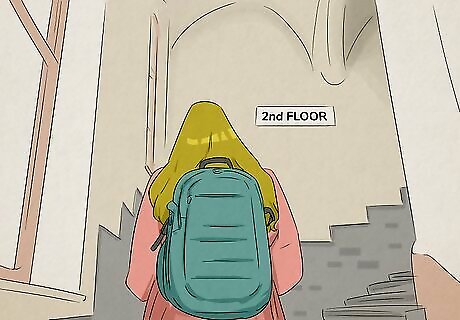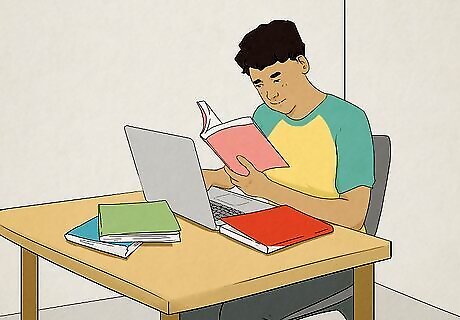
views
Tips for Studying at the Library

Bring any materials you might need. Decide which subjects you plan on studying during your library time and fill your backpack with any textbooks you need for that class. Also bring any past assignments or notebooks used to take notes in during that class. In addition to these materials, you might want to bring a pen and a highlighter. That way, you will be able to take more notes and to highlight the notes you already took. Bring your computer only if absolutely necessary. Some students prefer taking notes on their computer, or some may have digital copies of their textbooks, making a computer or e-reader necessary. If these tools are not essential, though, leave them at your place of residence. Otherwise, they will only serve as distractions.

Go to the library's "quiet floor." Libraries that only have one floor do not have a designated quiet floor, but libraries with multiple floors occasionally do. The floor is usually either the top or basement floor, rather than the main floor, since the main floor receives the most foot traffic and is likely to be the noisiest. Going to a quiet room to study ensures that you will face the least amount of distraction while at the library. If your library doesn't have a designated quiet area, scope out a spot that's out of the way, so you won't be distracted by other people passing by.

Sit at a small table. Libraries often have large rectangular tables and small circular tables. Opt for a smaller circular table, as long as one is available. These tables are usually big enough for you to spread your books and notes out onto without being so large that they invite others to come over and sit near you. Moreover, taking up a large table when you are only one person could be considered rude and wasteful. Feel free to take intermittent breaks where you get up and walk around. However, don't do this for too long.

Find a study desk, usually located in a back corner. Some libraries, especially those that are older or those linked to a university, actually have small desks in the library for students to work at. The desks are usually lined up, several in a row or cluster, along the back wall or corner of the library. Oftentimes, these desks have high sides to allow you to maintain your privacy and block out distractions from other students sitting at neighboring desks.

Reserve an individual study room. Newer libraries are usually built with study rooms, especially if the library is connected to a college or university. At large libraries that serve many patrons, you may need to reserve the study room in order to use it. Find out what your library’s policy regarding study rooms is. Rooms may need to be reserved anywhere from 24 hours to one week in advance, and there may be a time limit placed on how long students are allowed to use the room. If your library only has large meeting rooms available, you may not be able to reserve these for individual studying purposes. Note that many libraries offer their study rooms on a first come, first served basis. Essentially, if you arrive at the library and a room is open, you can use it. There may or may not be a time limit in these instances, but the librarian may ask you to leave if you do not appear to be working and others are waiting to use the room.
Studying with a Group

Only bring materials that are pertinent to your group work. Even if you would usually bring your computer or mp3 player to study while by yourself, leave that behind to study with a group. If you do pack these devices in your bag, be aware that you can only use them if your group takes a break or has self-study time during the meeting. Do not bring them out in the middle of the group work, and leave them behind altogether if you think you might be tempted to do so. As with individual study, make sure to bring any textbooks, notebooks, and past assignments need to study for the class or subject you plan on studying with your group. Also bring fresh notebook paper, pens, and highlighters.

Stick to a normal floor. If the library is large enough to have a designated quiet floor, stay off of it. Quiet floors are meant for individual study. During a group study session, you will need to speak with other group members. As such, you should stick with a floor that is not designated as a quiet area.

Find a large table. Make sure that everyone can fit comfortably. If you have a small group made of two or three people, a small circular table will still probably work. If you have a group that is larger than that, though, you will likely need a larger rectangular table.

Reserve a larger study room or meeting room. Some libraries have small study rooms set aside for individuals and slightly larger study rooms meant to fit groups of people. Find out what your library’s policy is concerning the use of these rooms. Oftentimes, you will need to reserve the room in advance, but this is not always the case. Some libraries will allow you to use any study room you please as long as it is open when you get there. For exceptionally large groups, you may want to consider asking about using a large meeting room at the library. These rooms tend to have stricter conditions placed on them. Use an open meeting room if the library will allow it. If a meeting room is not reserved by a group, some libraries may allow you and your study group to meet in there, especially if all the study rooms and other study areas are filled.

















Comments
0 comment